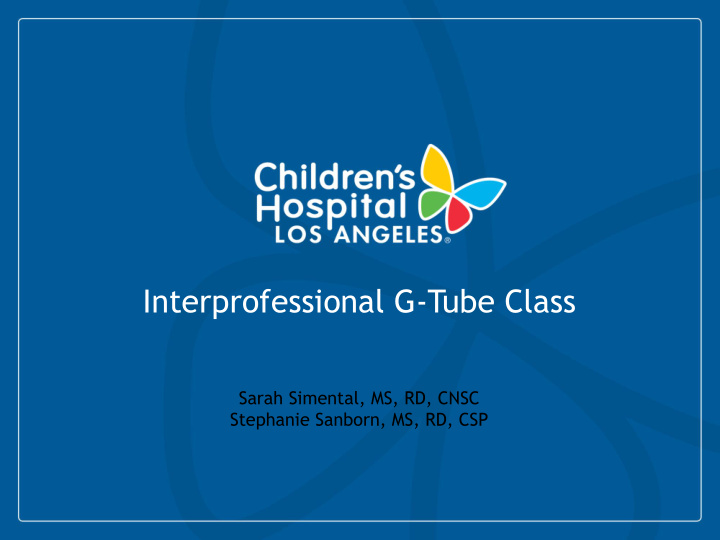



Interprofessional G-Tube Class Sarah Simental, MS, RD, CNSC Stephanie Sanborn, MS, RD, CSP
Objectives The Interprofessional G-Tube class at CHLA is a class for patients, parents, and caregivers to learn about what a gastrostomy tube is and how to care for it. Objectives: • Understand the need for an Interprofessional/comprehensive G-Tube class at CHLA • Discuss methods for implementing the Interprofessional G-Tube class • Understand the various disciplines’ roles within the class Discuss the beneficial outcomes and cost-savings for the hospital •
Introduction • A high rate of readmissions due to gastrostomy tube was identified through a needs assessment performed 197 readmissions within 1 year related to gastrostomy tube issues • In order to reduce readmissions and improve patient care outcomes, it was • determined that the best approach would be an interprofessional patient family education initiative Intregration of the GetWell Network and a specialty GT class was • developed • The interprofessional team includes the following: Clinical Nurses • Bedside RNs assist families with GetWell Network • • Clinical RN present to perform teaching during GTube class Registered Dietitians • • Child Life Specialists (CLS) Dysphagia Therapists (SLP/OT) • Social Workers •
GT Education Pathway • When a patient is identified as needing a feeding tube (or will possibly require one), the family is instructed to watch the G-Tube video on the GetWell Network • The video was developed by caregivers at CHLA as an informative video; can be viewed as often as needed Family (or any potential Caregivers) are then signed up for the G-Tube class • • All family members, patients, siblings, caregivers are invited Encouraged to have at least 2 caregivers to attend and learn care • Anyone who previously received a G-Tube and requires a refresher can also • sign-up for the class Including anyone identified by other medical providers that requires • further education
G-Tube Class Two classes are offered every Tuesday/Friday • AM class is offered in English • • PM class is offered in Spanish (both live/phone interpreters utilized) Other languages needed are pre-arranged and fit into one of the • classes Each class is about 3 hours long • Limited number of participants are allowed to keep class size small and • interactive In addition to lecture type learning, participants are able to practice skills • using mannequins
G-Tube Class Registered Dietitian Define and introduce the G-Tube • • Review various feeding regimens If families/caregivers have specific questions related to their child, • they are directed to speak with the floor/unit RD responsible Review necessary equipment and methods for obtaining all necessary • equipment/supplies • Review safe formula preparation and administration Review flushes and hydration •
G-Tube Class Social Work In Home Support Services (IHSS) 866-512-2857 888-944-4477 Shift Nursing contact your insurance provider Home and Community Based Alternatives 213-897-6774 916-552-9149 Regional Center (http://www.dds.ca.gov/RC/RCZIPLookup.cfm) Lanterman 213-383-1300 - Eastern 626-299-4700 Harbor (Torrance) 310-540-1711 - San Gabriel/Pomona 909-620-7722 South LA 213-744-7000 - Westside 310-258-4000 North Los Angeles 818-778-1900 Out of Home Placement LA DWP/Edison Medical Utility Assistance
G-Tube Class OT/SLP Introduce and define the role of the Dysphagia Team Introduce and define oral aversion -Facilitating oral interest -Providing positive oral experiences Review oral motor development -Why is oral stimulation important -What tools can help you provide stimulation for older children Discuss disuse atrophy Review Tummy Time and how to continue to implement when the child has a G-Tube
G-Tube Class Child Life Discuss the role of child life specialists in supporting • and educating patients and families learn and cope with medical experiences • Review developmental milestones pertinent to age of patients and siblings • How the G-tube can impact his/her development Understanding and participating in care • Importance of medical play • • Explain the G-tube to siblings and patients Address their concerns • • Families are given a handout about development and medical play to be a reference as patient grows
G-Tube Class Clinical Nurses (RN) Review the various G-Tube types • • Mic-Key, Corflo, Pezzar Discuss home care and maintenance of the tubes • Review troubleshooting for any issues that may be encountered • Provide hands-on practice with the actual tubes and care • Additional education provided: Additional teaching is provided by bedside RNs as needed • • DME Pharmacies also provide bedside teaching with the caregivers if the patients are discharged home with feeding pumps
Outcomes One year after implementation of G-Tube class, an 84% decrease in GT related readmissions was noted Sustained improvement with a 90% decrease in GT related readmissions over 2 years as compared to baseline year Number of GT Related Readmissions 180 160 140 120 100 Number of GT Related 80 Readmissions 60 40 20 0 Baseline Year 1 Year 2
Outcomes Implementation of the Inter-professional GT class generated an estimated 87% cost savings at CHLA Bedside GT teaching (including 3 disciplines) costs an estimated • $124,800/year Inter-professional GT class costs $15,808/year • Bedside GT Inter-professional Teaching (3 GT Class disciplines) $124,800 $15,808 yearly yearly (est.)
Questions??
Recommend
More recommend